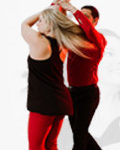In an earlier drill, we worked on finishing movement into compression. You learned to find the natural release point for compression, rather than bouncing out of compression because “that’s what the pattern does.” Now it’s time to put that technique into more complicated movements.
The Drill: With a partner, practice doing a left side tuck turn. You know what it feels like when you reach the natural release point for the compression. The drill is to try to make that point occur right as the tuck is ready to release on 4.
This drill is all about timing your absorption and release, so practice with a variety of musical tempos. You’ll want to include some really slow music in order to become aware of how the compression builds and releases. If you can’t make the compression smoothly build and release during slow music, chances are good you’ll feel like you are hitting a brick wall on faster music.
As you practice, become aware of how your body is set when you reach that natural release point. Leaders, this will become something you can manipulate in the dance. By delaying that moment, you can extend a movement in compression, which opens up the door for cool moves like leans, walkarounds, and other variations. Followers, you should train yourself to be sensitive to that moment as well, because if a leader wants to extend the compression, you want to be able to match that.
Side note: tucks are taught in a lot of different ways; sometimes they release on 3& while other times they release on 4. If you dance a syncopated triple (&3 4 instead of 3&4), the tuck will release on 3. The syncopated triple is very common in today’s dance because it naturally hits a downbeat, which is where a lot of breaks occur. The technique here will be the same regardless of when the tuck releases, but for the purposes of this drill we’ll practice with the compression building through 3& and hitting its maximum point just in time for the follower to be asked to step out on 4.
Both leaders and followers need to make sure that they are using their frames to absorb the compression, while keeping their frame with their body. (In other words, don’t push your arms forward of your body. When you extend your frame like that, it’s really hard to keep the energy moving from your frame to your center.)
[mediacredit inline=”FALSE”]




 Brian & Megan
Brian & Megan